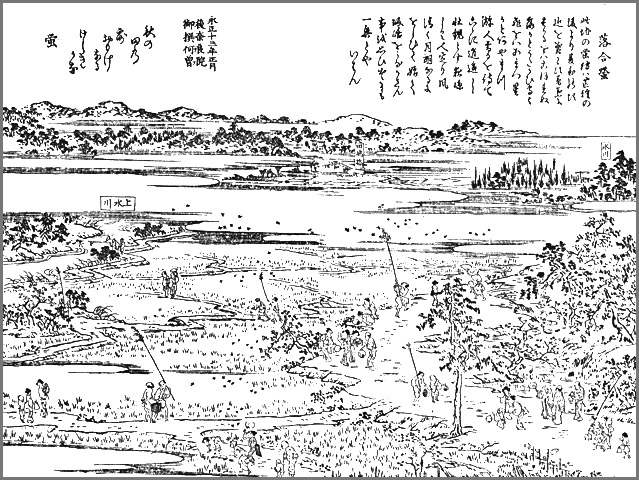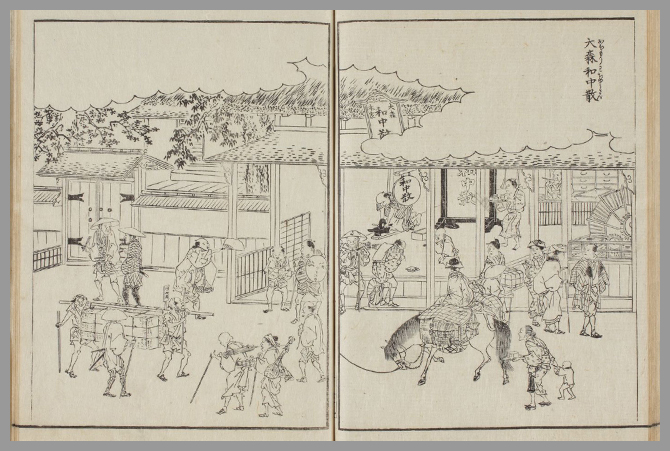. Famous Places and Powerspots of Edo 江戸の名所 .
::::::::::::::::::::::::::::::::::::::::::::::::::::::::::::::::::::::::::::::::::::::::::::::::::::::::::::::::::::::::::::::::::::::::::::::::::::::::::::::::::::::::::::::::::::
Ochiai 落合 Ochiai district
新宿区 Shinjuku 中落合 Naka-Ochiai, 上落合 Kami-Ochiai, 下落合 Shimo-Ochiai, 西落合 Nishi-Ochiai

The area where the river 神田川 Kandagawa and 妙正寺川 Myoshojigawa merged was called Ochiai. The area above the merger was Kami-Ochiai, the area downstream was Shimo-Ochiai.
The name Ochiai represents this "falling" ochi "together" ai of the two waterways into one river.
It used to be outside of the central area of Edo, but in 1818 it came under the administration of the Edo Bakufu government.
At that time a violet line was drawn on the map of Edo, and everything inside was
shubikinai 朱引内 within the "Vermillion Line"

At that time Ochiai was a rural district with farms and forests. It was blessed with clean water and many fireflies lived here.
The third Shogun Tokugawa Iemitsu used to come here for takagari 鷹狩 hunting with hawks.

落合地域では、御鷹野役所が設置されていた角筈村(現・新宿)まで、朝の五ツ半(午前9時ごろ)に受けとりに出かけることになる。下落合村の西隣り、上高田村の「堀江家文書」には、鷹狩りにかかった代金を角筈村へ受領しに出かけた、江戸後期の「請取証文」が保存されている。
- reference source : chinchiko.blog.so-net.ne.jp...-
.......................................................................
- quote
Ochiai is a district in Shinjuku located to the west of Takadanobaba Station. It’s also served by Ochiai Station on the Tokyo Metro Tozai Line.
Although the area is predominantly upscale residential, the area closer to Takadanobaba station has lots of reasonably priced restaurants and drinking establishments oriented towards the large local student population.
- source : tokyocheapo.com/locations...
..............................................................................................................................................
Ochiai hotaru 落合蛍 / 落合ほたる / 落合螢 fireflies at Ochiai

Painted by Hasegawa Settan 1834-1836
This scene shows the view when looking out from what is now Takadanobaba 3-chōme in the direction of Shimo-Ochiai.
In Edo times, the area was well-known for viewing fireflies, a fact also noted in contemporary guidebooks. Many people also visited the area to experience cool breezes on summer evenings.
- source : Tokyo Metropolitan Library -

広重 Hiroshige
「江戸自慢三十六興 落合ほたる」、

落合螢 - 黒沢明世 Kurosawa Akiyo
..............................................................................................................................................
Ochiai Water Reclamation Center 落合下水道局 Gesuido Kyoku

- quote -
Located very close to the subcenter of the Shinjuku area, Ochiai Water Reclamation Center is environment-friendly and thoroughly controlled as a water reclamation center surrounded by residential districts. The treatment area is in the Ochiai Treatment District (3,506 ha). It comprises Nakano-ku, and parts of Shinjuku, Setagaya, Shibuya, Suginami, Toshima and Nerima Ward.
The treated water
is discharged to Kanda River, with some part used effectively for toilet water in buildings of Nishi-shinjuku and Nakano-sakaue districts and for restoration of streams in three rivers which nearly dried up in the southern downtown area of Tokyo.
The generated sludge
is pumped through pressure pipelines to Tobu sludge plant for treatment.
- - - - - Sewerage Components
The sewerage system is principally made up of 3 facilities.
Sewers, which collect and carry sewage.
Pumping stations, where sewage is pumped up so that the sewers do not get too deep.
Water reclamation centers, where sewage is treated to be clean water.
Inspections, cleaning, and repairs are done daily in order to make sure each of these facilities works properly.
- Restoration of streams in three rivers in the southern downtown area of Tokyo
The reclaimed water after advanced waste water treatment in Ochiai Water Reclamation Center is fed into the three streams - Shibuya & Furu River, Meguro River and Nomi River, where water was stagnated and stream environment deteriorated in the past. This has contributed to the increase of water volume and recuperation of affluent water environment in the streams.
- - - Ochiai Summer Festa
We aim to be a water reclamation center loved by the local community. We hold this festival each year during summer vacation.
- - - Ochiai Chuo Park
Ochiai Chuo Park is the first park in Japan which was built using the upper part of a water treatment plant in 1964. This park is equipped with baseball park, tennis courts, etc. A large number of people visit and enjoy the parks.
- - - Seseragi no Sato Public Garden
Seseragi no Sato Public Garden has a chilidren's square with playground equipment, and the treated sewage through membrane filtration process flows in the waterway and the pond, providing the Garden with a comfortable waterside environment.
- - - - - Tokyo Sewerage Museum "Rainbow"

There is a facility to enjoy the experience of learning about the sewerage system, its roles, and the importance of water environment.
- source and details : gesui.metro.tokyo.jp/english... -
..............................................................................................................................................
Ochiai-eki 落合駅 Ochiai Station
is a subway station on the Tokyo Metro Tozai Line in Shinjuku.
The station opened on 16 March 1966.
::::::::::::::::::::::::::::::::::::::::::::::::::::::::::::::::::::::::::::::::::::::::::::::::::::::::::::::::::::::::::::::::::::::::::::::::::::::::::::::::::::::::::::::::::::
. Saishooji 最勝寺 Temple Saisho-Ji .
新宿区上落合3-4-12 / 3 Chome-4-12 Kamiochiai, Shinjuku
::::::::::::::::::::::::::::::::::::::::::::::::::::::::::::::::::::::::::::::::::::::::::::::::::::::::::::::::::::::::::::::::::::::::::::::::::::::::::::::::::::::::::::::::::::
. Legends and Tales from Japan 伝説 - Introduction .
Ochiai no Kappa 落合の河童 The Kappa from Ochiai
In 1571, there was a great famine in Edo. From spring to July it was only raining and everything was overflown.
In 落合村の下落合 the village of Ochiai in Shimo-Ochiai there was a mountain priest named 佐貫坊 Sanuki Bo, who had caught a Kappa. This Kappa had fallen in love with a 人魚 "human fish".
Sanuki Bo promised the Kappa that his love would be fulfilled, if he would stop the rain and flooding.
Thus he saved the area.

Kappa bottom right, human fish top right !
- KAPPA - 河童 / かっぱ / カッパ - ABC-Index -
..............................................................................................................................................
- reference : nichibun yokai database -
::::::::::::::::::::::::::::::::::::::::::::::::::::::::::::::::::::::::::::::::::::::::::::::::::::::::::::::::::::::::::::::::::::::::::::::::::::::::::::::::::::::::::::::::::::

- - - To join me on facebook, click the image !
:::::::::::::::::::::::::::::::::::::::::::::::::::::::::::::::::::::::::::::::::::::::::::::::::::::::::::::::::::::::::::::::::::::::::::::::::::::::::::::::::::::::::::::::::::::
. Shinjuku 新宿区 Shinjuku Ward .
. Edo bakufu 江戸幕府 The Edo Government .
. Famous Places and Powerspots of Edo 江戸の名所 .
. Doing Business in Edo - 商売 - Introduction .
. shokunin 職人 craftsman, craftsmen, artisan, Handwerker .
. senryu, senryū 川柳 Senryu poems in Edo .
. Japanese Architecture - The Japanese Home .
. Interior Design - The Japanese Home .
. Legends and Tales from Japan 伝説 - Introduction .
[ . BACK to DARUMA MUSEUM TOP . ]
[ . BACK to WORLDKIGO . TOP . ]
- - - - - #ochiai #ochiaishinjuku - - - -
::::::::::::::::::::::::::::::::::::::::::::::::::::::::::::::::::::::::::::::::::::::::::::::::::::::::::::::::::::::::::::::::::::::::::::::::::::::::::::::::::::::::::::::::::::




































